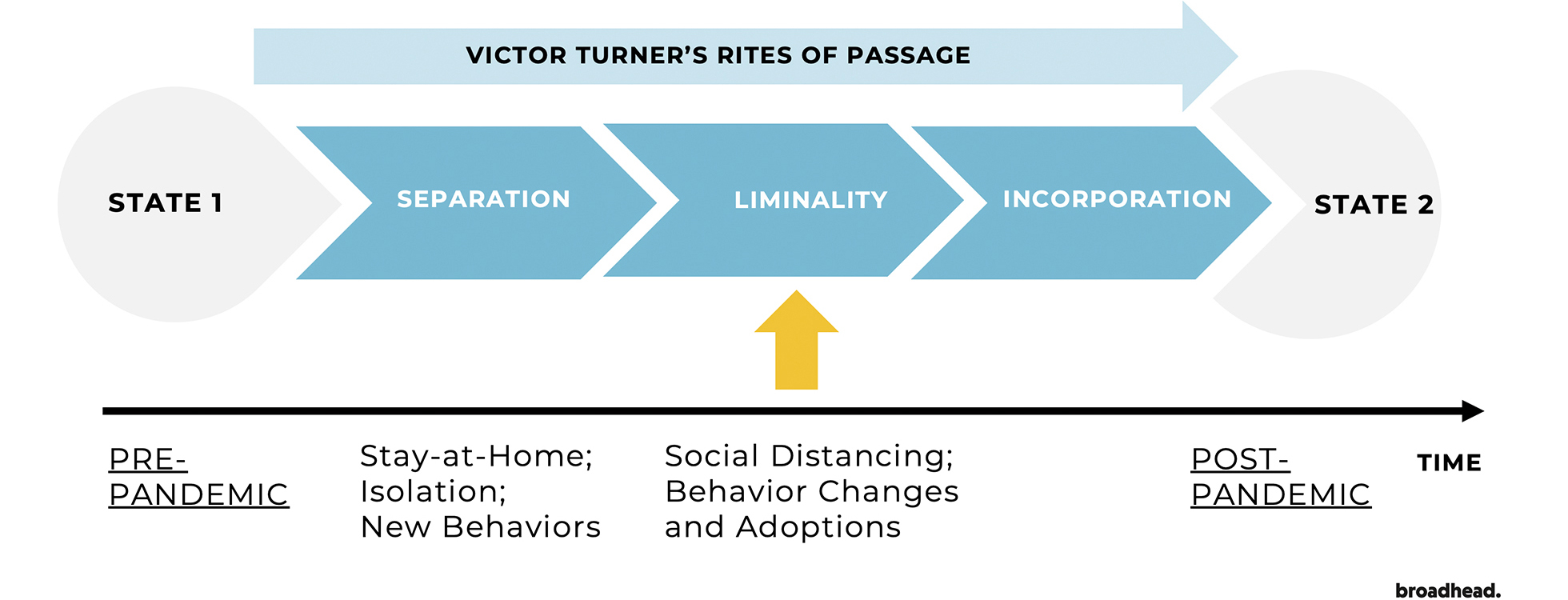Onward is an exclusive content series authored by broadhead’s thought leaders, highlighting their unique perspectives on adapting, adjusting and pushing forward.
Written by Emilie Hitch | VP, Applied Anthropologist
COVID-19 has created, and will continue to create, shifts in culture – forever altering the world as we know it. And while many of us feel like so much is still unknown – that we’re living day to day and hoping we’re making the right decisions – this “uneasy” feeling is actually a well-researched “state” of living. Anthropologist Victor Turner developed a model for “Rites of Passage” in his theoretical work on ritual and meaning. According to this model, there are various phenomenon which drive transformation from one “state” to another. A wedding is a good example – before the ritual, the bride and groom are not married; after the ritual – they are. But what, Turner wondered, about the during? He called this the “liminal state.”

Living through a pandemic, people around the world are experiencing collective liminality. The impacts of COVID-19 are driving culture-state transformations in phases similar to the states in Turner’s theoretical writing on rites of passage – separation, liminality and incorporation. Cultural markers and meanings are shifting – through language, behavior, values and beliefs, currency flows, power structures, relationships and other social forces.
While many smaller shifts are happening in real-time — shifts to our language, our media usage preferences and other daily detailed behaviors — there are larger culture-state transformations at work on our communities and societies, evolving with the course of the pandemic’s effects. Outlined below are some of the most dramatic shifts we’ve seen to date, and what they mean for brands and marketers.
- From trusting our systems to experiencing their breakdowns.
The 2008-2009 recession and economic downturn, in the U.S. in particular, led to an erosion of trust in institutions, creating fissures and thin ice that went ignored for a decade. Under the pressure of a pandemic, those fissures have since become fractures, and we are collectively witnessing various interconnected systems — healthcare, education, unemployment, food supply, justice system, travel, international trade, and more — breaking down. Add in an election year, and the true disservice of polarization in the U.S. is made visible as we question not only politicians, but also the leaders in science, healthcare, policy and the various affected organizations and government departments who must keep global systems running.
WHY IT MATTERS: Transparency has never been more important – nor our leaders more scrutinized and questioned. - From abundance to scarcity.
From food and travel to careers and social activities, our available choices shifted from accessible, reliable and autonomous, to limited, unstable and predetermined. The world shrank both geographically (for those with stay-at-home orders and border closings) and metaphorically (as the availability of activities, economic/buying options and relationships were cut off from entire cities and countries). Not to mention how the impact to business revenue and individual income generation has shrunk budgets as well. And all this uncertainty leads us to believe that supplies of everything else will run out as well. (Cue the panic buying.)
WHY IT MATTERS: While the supply chain actually remained relatively untouched by COVID-19’s initial effects, consumer perception shifted from living in abundance to navigating scarcity due to media coverage and collective fear and uncertainty. - From panic to preparation
Through the course of the pandemic, people have settled in to new routines and habits – it’s likely we won’t buy 50lb bags of potatoes again, or 100s of rolls of toilet paper, but we will “stock up” on the things we still deem essential week by week. We want to be prepared for whatever comes next – with healthy pantries, and resilient social structures. Many people are figuring out how to homeschool in pods, for example – if the school districts won’t be prepared, people are taking matters into their own hands (and wallets). Our expectations have risen across the board for how organizations (and brands) contribute positively to society at large: from sustainability and safety, to stability and inclusion.
WHY IT MATTERS: From grocery shopping and airline travel to the healthcare and school systems, we want to greet whatever comes next with ease – and we expect corporations and government to be prepared. - From the individual to the collective.
We crave connection. Social connection, to be sure (case in point, the emergence of “quarenteams” and “Netflix parties”), but also connections to a bigger story. The public has learned more about “the supply chain” in the last five months than in the five years before them; we want to know where products come from, how they are made, how they can be disposed of, and how the organization providing those products has taken real action to make the world a better place.
WHY IT MATTERS: We recognize how much of our own well-being and way of life depends on others – and our expectations for collective impact are rising. Finding alignment between our purchases and our purpose in life has never felt more important. - From “more for less” to “better for more.”
Our lives may have paused but our emotional and cultural changes have only accelerated, prompting us to focus on what really matters in a world of scarcity – identifying the things and experiences that give life meaning. American state parks are experiencing a 50-160% increase in visitors from the same months a year ago. Sales of organic products see no sign of slowing as we double down on eating healthy. People are demanding transparency – not only on labels, but about business practices. Demand is increasing for products with ingredients from regenerative practices (from leather belts to breakfast cereals) and a strong carbon story. People are dedicated to shopping local and seeking out minority-owned businesses.
WHY IT MATTERS: When consumers say they want “better,” they mean it in every piece and practice of how humans get things done.
Culture will continue to shift as the pandemic touches every aspect of life. But for now, in this “liminal state,” brands and marketers need to pay close attention to how they’re addressing transparency, choice, preparation, purpose and meaning. These core themes are driving purchase intent and are key to acquiring and retaining customers.
Interested in hearing more from Emilie on COVID-19 and culture? Want to know her predictions for the future? Feel free to email her at [email protected].
Citations: Söderlund, Jonas & Borg, Elisabeth. (2017). Liminality in Management and Organization Studies: Process, Position and Place. International Journal of Management Reviews. 10.1111/ijmr.12168. Turner, Victor (1967). “Betwixt and between: the liminal period in rites de passage”. Forest of symbols: aspects of the Ndembu ritual. Ithaca: Cornell UP. pp. 23–59. Turner, Victor W. (1969). The Ritual Process. Penguin. Van Gennep, Arnold (1909). Les rites de passage (in French). Paris: Émile Nourry. Lay summary – Review by Frederick Starr, The American Journal of Sociology, V. 15, No. 5, pp 707-709 (March 1910).
